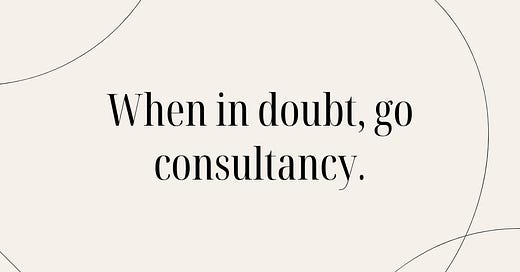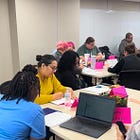This will be a little bit shorter than that OG Back-to-School PD edition because it should be. Why?
1) It is often only 1 day or part of a day.
2) People need to time when they get back. Filling the time with content is not the vibe.
3) The main initiatives are not being introduced but are being refined.
If you haven’t read the back-to-school PD edition, you should. It contains essential information about designing PD and launching initiatives.
Back-to-School PD Edition
If you spend time on Instagram or TikTok, you know that back-to-school PD is the ultimate punchline. Teachers hate it, and there’s good reason to. Frankly, back-to-school PD often sucks, and teachers have a million things to do before children arrive. If you steal a teacher’s time, you better make it count.
Why Back-from-Break PD? (Reprise)
1. Reflection and Planning
Think of PD as the ultimate reset button. It’s a chance to reflect on what worked, what didn’t, and how to improve this year. Reflecting on past experiences and planning thoughtfully can turn past mistakes into future successes.
What plans do you need the WHOLE STAFF to be in on?
What data is important to put in front of staff?
2. Skill Enhancement
Education, like fashion, is ever-evolving. You can't rely on outdated teaching methods, just as you wouldn’t wear last season’s trends. PD, grounded in data and evidence, equips you with the latest skills and strategies to keep your teaching fresh and effective for your specific group of students.
What do staff need to practice?
What narrow instructional strategies are important for success at this school?
3. Addressing Challenges:
The classroom can sometimes feel like an obstacle course. PD prepares you to navigate the hurdles—supporting students’ emotional health, adopting new curricular resources in its next implementation phase, or adapting to new educational norms.
What was a sticking point for us?
How do we prevent those issues this year?
How will that problem be addressed? How will we know we are successful?
4. Alignment with Goals:
Effective PD aligns teaching with school and district goals, creating a unified approach that ensures everyone pulls in the same direction. Alignment yields collective efficacy.
What goals must be made clear? How will staff internalize them?
What specific actions will drive progress toward these goals?
5. Collaboration and Sharing:
Teaching can be an isolating profession. Research on teacher retention shows that relationships matter. PD provides opportunities to collaborate, share best practices, and learn from colleagues, fostering a sense of community and support.
How do we build a collective team working towards this mission?
How will staff voice and choice be integrated?
When in doubt, go consultancy.
The consultancy protocol is a structured and collaborative approach to addressing dilemmas or problems of practice. It’s designed to encourage expansive thinking, self-reflection, and actionable insights. As one seasoned colleague once told me when I was a terrified 30-year-old assistant superintendent, "They have the solutions, just get them talking." This framework embodies that wisdom.
They have the solutions, just get them talking.
What Is the Consultancy Protocol?
At its core, the consultancy protocol facilitates a safe, structured process for exploring challenges.
Presenter overview
Clarifying questions
Probing questions
Group discussion
Presenter reflection
Debriefing
The goal isn’t to leap to solutions but to deeply explore the problem, leading to creative and well-informed pathways forward.
A well-defined problem is half solved. - John Dewey
Why Is It Ideal for Post-Winter-Break PD?
1. Regrounding in Priorities
Coming off the holiday break, the protocol helps teams reconnect with their core goals and challenges. It organically surfaces priorities by focusing on dilemmas they identify as most pressing.
2. Natural Differentiation
Because the protocol is based on individual or team dilemmas, it allows for differentiation without additional prep work. Each group addresses what matters most to them, ensuring relevance across a diverse staff.
3. Social Connection and Trust
The holidays often highlight our need for connection, and the protocol provides a space for teams to reestablish trust and collaboration. Participants feel heard and supported, which fosters a more cohesive work environment.
4. Empowers Teams and Reduces Leader Workload
As the leader, you get to take a step back. Your role becomes facilitative rather than directive, allowing ideas and priorities to surface organically. As a bonus, it requires far less prep than traditional PD sessions.
“If you got a problem, yo – we’ll solve it.”
The result? Teams leave feeling empowered, aligned, and ready to tackle the semester ahead. This process delivers impactful outcomes with minimal stress and prep.
Strong Dilemmas Drive Consultancies
The best consultancies are done when people have time to do pre-work about their dilemma. Coming off of a break, people may be unable to pull a great dilemma out of the brain. Consider giving them time to generate their dilemma and provide examples and non-examples for your context.
Example: How might we get students to produce higher-quality writing? This is an example because it is within their locus of control, derived from student-outcome evidence and/or data, and can result in collaborative solutions.
Non-Example: How might we get parents to care? This is a non-example because it’s rooted in generalizations and mostly outside of their locus of control.
Effective dilemmas are:
Within Your Locus of Control: Dilemmas should focus on challenges the team or individual can influence or change. Avoid framing issues that depend entirely on external factors or individuals outside the immediate context.
Student-Centered and Evidence-Based: The best dilemmas stem from observable student behaviors, outcomes, or data. They address challenges tied to teaching practices, learning experiences, or classroom dynamics rather than abstract or anecdotal concerns.
Actionable and Specific: A strong dilemma is focused enough to generate actionable steps. Avoid broad or vague challenges that are difficult to address in a single session.
Open-Ended: Effective dilemmas invite exploration and multiple perspectives. They are framed as "How might we" or "What strategies can we use to…" questions, encouraging creative and collaborative thinking.
Aligned to Goals or Priorities: Ideally, dilemmas connect to broader school or team objectives, ensuring the conversation is both relevant and impactful.
Give this criteria to the staff. Provide as many examples as you need. Here are a few more:
My Recommendations for Back-From-Break PD
Skip the ice-breakers unless you need a relationship reset or you have new staff.
Revisit key instructional priorities by:
Unpacking at an exemplar AND/OR
Practicing a specific or narrow aspect of the priority
When in doubt, go consultancy.
Give the time back for planning, preparation, and relevant team time.
BONUS for paid subscribers or purchase it here for only $1.
Keep reading with a 7-day free trial
Subscribe to EduCoach by Jo Lein to keep reading this post and get 7 days of free access to the full post archives.











